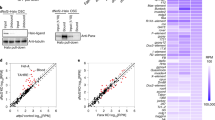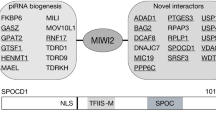Abstract
Piwi proteins and their associated Piwi-interacting RNAs (piRNAs) are implicated in transposon silencing in the mouse germ line. There is currently little information on additional proteins in the murine Piwi complex and how they might regulate the entry of transcripts that accumulate as piRNAs in the Piwi ribonucleoprotein (piRNP). We isolated Mili-containing complexes from adult mouse testes and identified Tudor domain–containing protein-1 (Tdrd1) as a factor specifically associated with the Mili piRNP throughout spermatogenesis. Complex formation is promoted by the recognition of symmetrically dimethylated arginines at the N terminus of Mili by the tudor domains of Tdrd1. Similar to a Mili mutant, mice lacking Tdrd1 show derepression of L1 transposons accompanied by a loss of DNA methylation at their regulatory elements and delocalization of Miwi2 from the nucleus to the cytoplasm. Finally, we show that Mili piRNPs devoid of Tdrd1 accept the entry of abundant cellular transcripts into the piRNA pathway and accumulate piRNAs with a profile that is drastically different from that of the wild type. Our data suggest that Tdrd1 ensures the entry of correct transcripts into the normal piRNA pool.
This is a preview of subscription content, access via your institution
Access options
Subscribe to this journal
Receive 12 print issues and online access
$189.00 per year
only $15.75 per issue
Buy this article
- Purchase on Springer Link
- Instant access to full article PDF
Prices may be subject to local taxes which are calculated during checkout






Similar content being viewed by others
Accession codes
References
Filipowicz, W., Bhattacharyya, S.N. & Sonenberg, N. Mechanisms of post-transcriptional regulation by microRNAs: are the answers in sight? Nat. Rev. Genet. 9, 102–114 (2008).
Aravin, A.A., Hannon, G.J. & Brennecke, J. The Piwi-piRNA pathway provides an adaptive defense in the transposon arms race. Science 318, 761–764 (2007).
Seto, A.G., Kingston, R.E. & Lau, N.C. The coming of age for Piwi proteins. Mol. Cell 26, 603–609 (2007).
Brennecke, J. et al. Discrete small RNA-generating loci as master regulators of transposon activity in Drosophila . Cell 128, 1089–1103 (2007).
Kuramochi-Miyagawa, S. et al. Mili, a mammalian member of piwi family gene, is essential for spermatogenesis. Development 131, 839–849 (2004).
Aravin, A.A. et al. A piRNA pathway primed by individual transposons is linked to de novo DNA methylation in mice. Mol. Cell 31, 785–799 (2008).
Deng, W. & Lin, H. miwi, a murine homolog of piwi, encodes a cytoplasmic protein essential for spermatogenesis. Dev. Cell 2, 819–830 (2002).
Aravin, A.A., Sachidanandam, R., Girard, A., Fejes-Toth, K. & Hannon, G.J. Developmentally regulated piRNA clusters implicate MILI in transposon control. Science 316, 744–747 (2007).
Aravin, A. et al. A novel class of small RNAs bind to MILI protein in mouse testes. Nature 442, 203–207 (2006).
Kuramochi-Miyagawa, S. et al. DNA methylation of retrotransposon genes is regulated by Piwi family members MILI and MIWI2 in murine fetal testes. Genes Dev. 22, 908–917 (2008).
Chuma, S. et al. Mouse tudor repeat-1 (MTR-1) is a novel component of chromatoid bodies/nuages in male germ cells and forms a complex with snRNPs. Mech. Dev. 120, 979–990 (2003).
Liu, Y. et al. Structural basis for recognition of SMRT/N-CoR by the MYND domain and its contribution to AML1/ETO's activity. Cancer Cell 11, 483–497 (2007).
Friesen, W.J., Massenet, S., Paushkin, S., Wyce, A. & Dreyfuss, G. SMN, the product of the spinal muscular atrophy gene, binds preferentially to dimethylarginine-containing protein targets. Mol. Cell 7, 1111–1117 (2001).
Brahms, H. et al. The C-terminal RG dipeptide repeats of the spliceosomal Sm proteins D1 and D3 contain symmetrical dimethylarginines, which form a major B-cell epitope for anti-Sm autoantibodies. J. Biol. Chem. 275, 17122–17129 (2000).
Hebert, M.D., Shpargel, K.B., Ospina, J.K., Tucker, K.E. & Matera, A.G. Coilin methylation regulates nuclear body formation. Dev. Cell 3, 329–337 (2002).
Boisvert, F.M. et al. Symmetrical dimethylarginine methylation is required for the localization of SMN in Cajal bodies and pre-mRNA splicing. J. Cell Biol. 159, 957–969 (2002).
Meister, G. & Fischer, U. Assisted RNP assembly: SMN and PRMT5 complexes cooperate in the formation of spliceosomal UsnRNPs. EMBO J. 21, 5853–5863 (2002).
Gonsalvez, G.B. et al. Two distinct arginine methyltransferases are required for biogenesis of Sm-class ribonucleoproteins. J. Cell Biol. 178, 733–740 (2007).
Chuma, S. et al. Tdrd1/Mtr-1, a tudor-related gene, is essential for male germ-cell differentiation and nuage/germinal granule formation in mice. Proc. Natl. Acad. Sci. USA 103, 15894–15899 (2006).
Lane, N. et al. Resistance of IAPs to methylation reprogramming may provide a mechanism for epigenetic inheritance in the mouse. Genesis 35, 88–93 (2003).
Martin, S.L. & Branciforte, D. Synchronous expression of LINE-1 RNA and protein in mouse embryonal carcinoma cells. Mol. Cell. Biol. 13, 5383–5392 (1993).
Aravin, A.A. & Bourc'his, D. Small RNA guides for de novo DNA methylation in mammalian germ cells. Genes Dev. 22, 970–975 (2008).
Carmell, M.A. et al. MIWI2 is essential for spermatogenesis and repression of transposons in the mouse male germline. Dev. Cell 12, 503–514 (2007).
Zhao, Q. et al. PRMT5-mediated methylation of histone H4R3 recruits DNMT3A, coupling histone and DNA methylation in gene silencing. Nat. Struct. Mol. Biol. 16, 304–311 (2009).
Botuyan, M.V. et al. Structural basis for the methylation state-specific recognition of histone H4–K20 by 53BP1 and Crb2 in DNA repair. Cell 127, 1361–1373 (2006).
Selenko, P. et al. SMN tudor domain structure and its interaction with the Sm proteins. Nat. Struct. Biol. 8, 27–31 (2001).
Wang, J., Saxe, J.P., Tanaka, T., Chuma, S. & Lin, H. Mili interacts with tudor domain-containing protein 1 in regulating spermatogenesis. Curr. Biol. 19, 640–644 (2009).
Kirino, Y. et al. Arginine methylation of Piwi proteins catalysed by dPRMT5 is required for Ago3 and Aub stability. Nat. Cell Biol. 11, 652–658 (2009).
Anne, J., Ollo, R., Ephrussi, A. & Mechler, B.M. Arginine methyltransferase Capsuleen is essential for methylation of spliceosomal Sm proteins and germ cell formation in Drosophila . Development 134, 137–146 (2007).
Gonsalvez, G.B., Rajendra, T.K., Tian, L. & Matera, A.G. The Sm-protein methyltransferase, dart5, is essential for germ-cell specification and maintenance. Curr. Biol. 16, 1077–1089 (2006).
Lim, A.K. & Kai, T. Unique germ-line organelle, nuage, functions to repress selfish genetic elements in Drosophila melanogaster . Proc. Natl. Acad. Sci. USA 104, 6714–6719 (2007).
Pivot-Pajot, C. et al. Acetylation-dependent chromatin reorganization by BRDT, a testis-specific bromodomain-containing protein. Mol. Cell. Biol. 23, 5354–5365 (2003).
Soper, S.F. et al. Mouse maelstrom, a component of nuage, is essential for spermatogenesis and transposon repression in meiosis. Dev. Cell 15, 285–297 (2008).
Jurka, J. Repbase update: a database and an electronic journal of repetitive elements. Trends Genet. 16, 418–420 (2000).
Kent, W.J. et al. The human genome browser at UCSC. Genome Res. 12, 996–1006 (2002).
Acknowledgements
We thank A. Aravin and G. Hannon (Cold Spring Harbour Laboratory), J. Martinez (Institute of Molecular Biotechnology, Vienna), S. Martin (University of Colorado School of Medicine), A. Bortvin (Carnegie Institution of Washington) and D. Schuemperli and M. Ruepp (University of Bern) for reagents. We thank the European Molecular Biology Laboratory (EMBL) Mononclonal Antibody Facility, Protein Expression and Gene Core facilities for antibody production and Solexa sequencing. We are grateful to D. O'Carroll, A. Verdel and W. Filipowicz and members of the Pillai group for excellent discussions and reading of the manuscript. Research in the Pillai group is supported by EMBL and a grant from Region Rhone Alp (CIBLE 2008).
Author information
Authors and Affiliations
Contributions
M.R. performed most of the experiments described in this study; S.C. provided immunostaining data and Tdrd1 mutant mice; T.T. purified germ cells by FACS; T.F. provided MS analysis; A.S. performed Solexa sequence analysis; R.S.P. designed the research and wrote the paper.
Corresponding author
Supplementary information
Supplementary Text and Figures
Supplementary Figures 1–5 and Supplementary Tables 1–4 (PDF 1142 kb)
Rights and permissions
About this article
Cite this article
Reuter, M., Chuma, S., Tanaka, T. et al. Loss of the Mili-interacting Tudor domain–containing protein-1 activates transposons and alters the Mili-associated small RNA profile. Nat Struct Mol Biol 16, 639–646 (2009). https://doi.org/10.1038/nsmb.1615
Received:
Accepted:
Published:
Issue Date:
DOI: https://doi.org/10.1038/nsmb.1615
This article is cited by
-
Emerging evidence that the mammalian sperm epigenome serves as a template for embryo development
Nature Communications (2023)
-
Building RNA-protein germ granules: insights from the multifaceted functions of DEAD-box helicase Vasa/Ddx4 in germline development
Cellular and Molecular Life Sciences (2022)
-
Arginine methylation promotes siRNA-binding specificity for a spermatogenesis-specific isoform of the Argonaute protein CSR-1
Nature Communications (2021)
-
MORC3, a novel MIWI2 association partner, as an epigenetic regulator of piRNA dependent transposon silencing in male germ cells
Scientific Reports (2021)
-
Binding of guide piRNA triggers methylation of the unstructured N-terminal region of Aub leading to assembly of the piRNA amplification complex
Nature Communications (2021)



